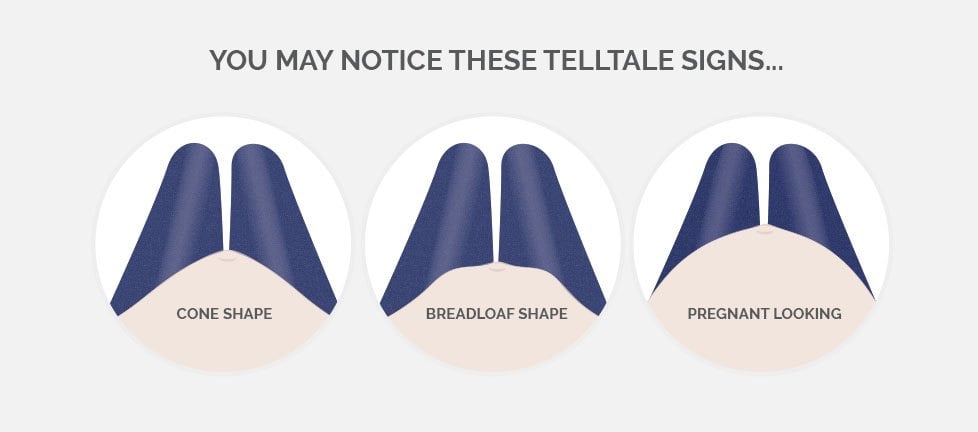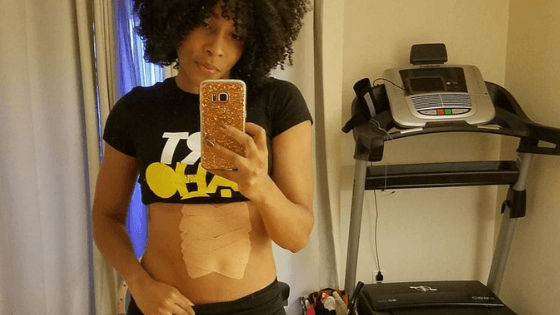We often hear that crunches, curl-ups or planks are not recommended for exercising with diastasis recti. Why? When and how can we do traditional ab exercising with diastasis recti? And what should we do instead of crunches?
Why are planks or crunches often not recommended?
Standard crunches, sit-ups or full planks are often not recommended for exercising with diastasis recti. This is because the way a crunch is usually performed may have the effect of increasing intra-abdominal pressure. This means pressure inside that pushes your organs outwards, against or through the gap, and/or downwards onto your pelvic floor. IE directions you really don’t want your organs forcefully heading. These exercise movements simply place excess load on the front of your abs and the gap.

You can actually see what you’re training your abs to do if you look straight down as you curl up: a cone shape, bread-loaf shape or a pregnant looking belly. These may be signs of diastasis recti, or that your core is not functioning optimally, and not the effect you’re trying to achieve.
So, many experts recommend eliminating these movements when exercising with diastasis recti At least until the core musculature (including the pelvic floor) is restored and strong enough to withstand the movement.
We know you need to build the foundations of a restored, functional and strong core first.
Exercising with diastasis recti – building the foundations
Crunches, planks or heavy lifting are not bad or taboo exercises. No movements are. But it’s important to build the foundations of core and pelvic floor function first, so that you can do them safely.
Diastasis recti is a gap between the muscles at the front of your abs. A small-ish gap may not be a problem at all, and you can have a strong functional core with a small gap. Watch the video on how to test and recognise diastasis recti symptoms here. You may see bulging or doming, you may feel like you;re ‘falling out at the front’ when you perform some movements or exercises.
So before you train your abs hard, you want to ensure the deeper abdominal muscles are actually recruiting (meaning… ‘kicking in’ and working). These muscles are the Transverse, the Inferior and Exterior Obliques, the Rectus Abdominis, along with the muscles of your pelvic floor.
This vital phase of mind-to-muscle reconnection. Learning to recruit and engage the right muscles, first in isolation and then as a unit, must come first. That’s what MUTU System does.
Introducing crunches and other ab exercises back into your workouts
Done right, crunches may be fine with a diastasis recti, once you’ve established function again with foundational exercises. Supine spinal flexion (that means curling up from lying on your back) engages and shortens the ‘six-pack’ abdominal muscle or Rectus. The one that’s stretched out, with the gap. So exercising to shorten it, if performed correctly, can be a good thing.
And anyway, bending forward like this is a perfectly useful human, functional movement! We sometimes need to do it, and we may want to do these type of ab exercises.
Safe ab exercising with diastasis recti
To perform a curl or crunch, keep the range of movement very small at first. By that I mean don’t lift your head and shoulders very high off the ground – there is no muscular benefit to curling right up anyway. And keep the levers short – so knees bent up, feet flat on the floor.
Inhale fully with your head and shoulders completely relaxed on the floor. Then exhale slowly and focus on gently engaging your abdominal muscles as well as your pelvic floor muscles, as you lift your head and shoulders just off the floor. Relax completely back down on the inhale. Watch for doming, straining and be mindful of how your pelvic floor feels.
Remember that crunches with straight legs, outstretched arms, raised legs or any adjustment that increases the load, will increase the strain. Avoid these progressions until your core is fully healed and restored.
Want to start progressing a plank? Start on all fours, and gradually shimmy your knees back, keeping shoulders over hands. This way you gradually increase the lever, or load on your abs. If you start to shake, feel like you’re falling out at the front, then thats your limit for now. Bring your knees back in a little. Stay there awhile and try again next time.
What to watch out for when exercising with diastasis recti
First, don’t hold your breath. This is really common when doing ab exercises, even if you don’t know you’re doing it! Breath-holding builds up pressure, and may cause your stomach to pooch or bulge out and your organs to bear down.
Often your hip flexors and lower back are taking the strain in a curl-up movement. This is especially an issue if you restrain your feet when crunching. The muscles you intend to target are not recruiting at all, whilst the diastasis gap could be widening further.
If you feel or see the following, stop, or back up to an easer version. Don’t ‘push through’ shaking, pain or any of these signs. They are your body’s clear signals you’re not ready for this stage of the movement just yet.
Warning signs to stop
- Bulging or doming anywhere on your abdomen when you do any exercise
- Bulging in or from your vagina or rectum, or any feeling of heaviness or ‘bearing down’
- Pain – In your back, pelvis, abdomen, hips or leg
- Leaking urine or faeces when you sneeze, laugh or cough; or leaking as you’re rushing to the toilet
So be sure to gauge whether you can maintain the tension at the front of your abs, and in your pelvic floor. If you’re not sure, either have a Women’s Health Physio check your technique, OR refrain from these moves for now until you know your core function is restored and you can engage the muscles correctly. Otherwise you could do more harm than good. It is preferable and much safer that you find alternatives with techniques and patterns which have less potential to harm.
Most important: The movement is not a bad movement. You just need to be sure you’re getting it right, and that your body is ready for it.









